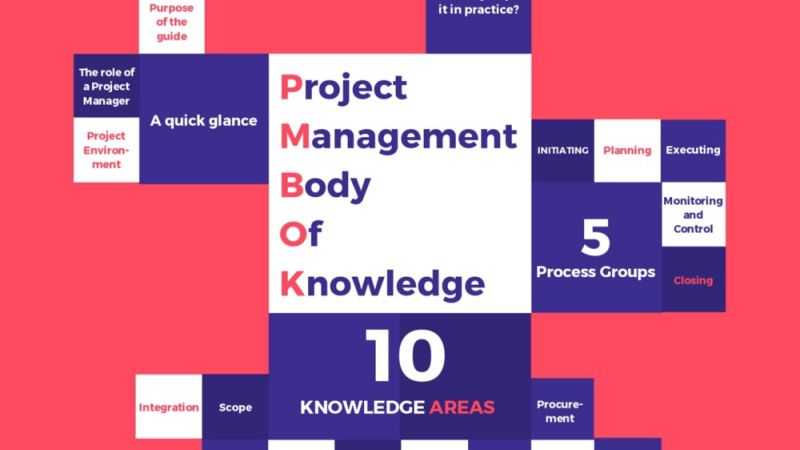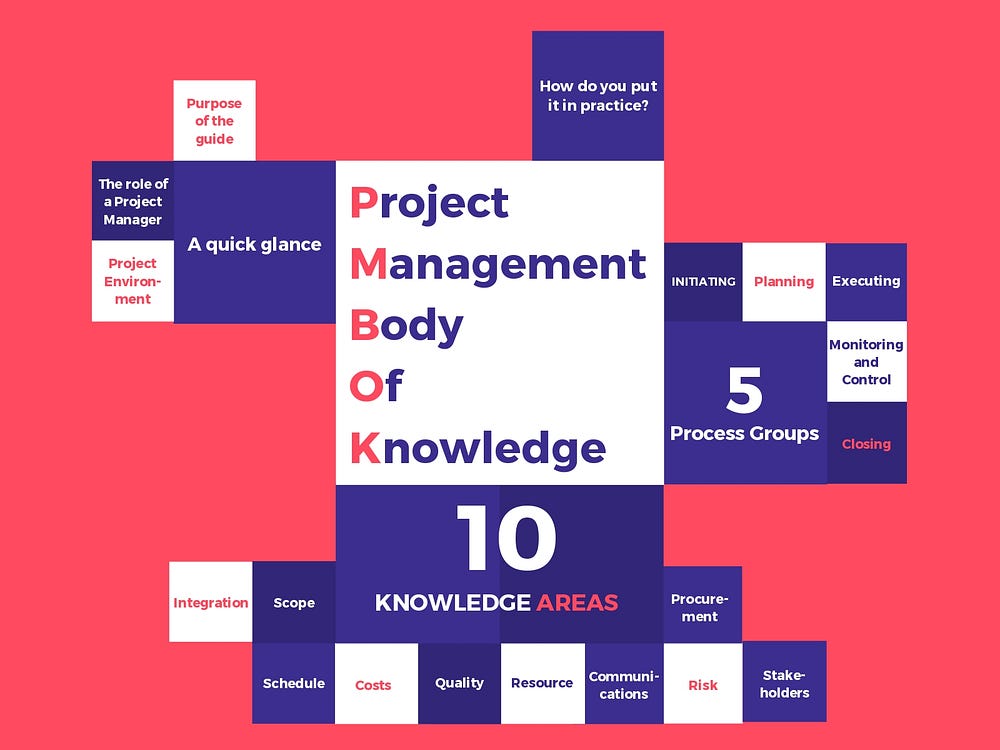PMBOK and Real Madrid in one package

You can find the original post here.
Real Madrid stadium is in serious danger: a scheduled inspection has found out the construction flows that will eventually bring down the east wing of Bernabéu. Unfortunately, this “eventually” is in the closest future — it is measured that in 6 months The Whites will lose their White House.
But it’s not over yet, Chip ‘n Dale our team is here to the rescue. We will put into practice the best of PMBOK to cope with adversities.
In short, the plan is the following: we have 3 months to do all the planning whilst the stadium is going to be operating. Then, we bulldoze the lot and construct the new star of construction — X. In the meantime, Madrid will play in Wanda. The estimated time for construction is 2 years. Total project execution time: 2 years 3 months.
So, let’s dig into PMBOK — a 711-page book full of ideas and see what we can do.
PMBOK stands for Project Management Body of Knowledge
It is a guide developed by the Project Management Institute, which aims at explaining and standardizing generally accepted knowledge and principles that can be applied to projects of any nature (note: any nature, so far we are good).
One of the extensions of the PMBOK is the Practices Guide, which establishes the best practices to be adopted when applying PMBOK standards while developing a project.
Our job, as project managers, is to apply the PMBOK notions into practice. We will be in charge of leading the project team to achieve the objectives that have been set, coordinating and controlling project resources, managing project restrictions and applying the standards.
So, how do the different parts of PMBOK relate?
This guide consists of 10 knowledge areas and 5 macro stages. Every knowledge area goes through some or all of the five macro stages.

In order to achieve the maximum results, we (aka project managers) will need to apply the organizational and analytical skills to design the best framework by identifying the five project management process groups:
- The Initiating Process Group might seem like the easiest part of a project, but it is more important than you can think: it will determine the direction of every plan within the project. Every project is undertaken in a certain environment, by which it is conditioned. During the initiating process group, we will analyse the environment and identify impact factors. In our case, it’s stakeholders, authorities and customers.
- The Planning Process Group is the most responsible part of the project’s development because it will establish the steps to achieve success: the scope, the strategies, priority task lists, and allocation of the resources.
- In the Executing Process Group, we will set up the working process in order to reach every metric and benchmark goals. For instance, there are certain deadlines to comply with: finishing the door installations in one week, changing rooms in two weeks, etc. This is a practical and testing stage, so we have to be prepared for any complex situation.
- The Monitoring and Control Process Group offers a great opportunity for a team to address any changes coming from the planning process. For example, some orders can be changed or budget reassigned. This is the stage for identifying threats and fixing the flows. To successfully pass it through, we will have to give a quick response to any outcome of the project.
- The Closing Process Group is a culmination phase of the project when we will able to assess what has worked and what has failed. The last process group is mainly related to submitting the necessary documentation and doing paperwork. This stage is as important as the others because it will lead to a good closure of the project, exploring new possibilities.
So, let’s get it started!
For all these marvellous plans to become true, Real Stadium needs a board of directors. That is where Project Stakeholder Management (1) comes in handy. In a few words, the goal is to analyse the stakeholders’ expectations and engage them in the process.
Search for people that could impact or be impacted by the project.
Of course, they can impact the project in a positive or negative way, that’s why a structured approach to correctly identify and engage the stakeholders can mean the difference between project success and failure. To increase the chances of success, it needs to be done as soon as possible after the project path has been approved to make sure everyone is on the same page.
To seek for something unknown is not the best strategy. Firstly, try to understand what kind of people you are looking for. Team brainstorming and brainwriting are highly recommended.
So, at the early stage of Real Stadium construction, we are searching for 2 types of stakeholders: 1 proactive leader full of ideas that will be interested in the constant improvement of the project and 2 more careful and considered advisors that will try to measure the risk of every idea proposed. It would be beneficial for them to have a football club management experience and they must contribute a certain capital.
This phase results in a list of possible stakeholders and relevant information about them: what level of interest they show to the project, what special knowledge they have, what tangible and intangible resources they can contribute. To make the best choice, we have categorized the aspirants into groups.

Our final choice is Álvaro, Cristina and Rafael. Cristina’s youth will be compensated with Rafael’s deep knowledge of the subject. The lack of experience will incentive her to consider colleagues’ opinions twice. Even though Rafael is not flexible, Álvaro’s analytical approach will balance it out. Cristina’s experimental ideas will be thoroughly evaluated by her wiser partners. Excessive control of Álvaro will be a discussion point in the board of directors, although, when he gets to know his colleagues better, he will learn to trust them and will loosen his grip. The positive traits of Emilio and Sara can’t compensate for the inability to be fully committed or slowly decision-making because our project has a strict deadline.
It is good to remember that when the deal is sealed, you can’t make deliberate changes to the project plan, so during negotiation, don’t forget to discuss the option of changing the plan on the way!
The key benefit of planning the stakeholders’ engagement is that you can see a full picture of how your project is going to be executed on practice. At this stage, a few things need to be clear: what is the best ICT to use?; what are the complexities of communication? Interaction with the stakeholders is essential for leading your project in the right direction.
Engagement = communication
The concept of co-creation will design a comfortable environment for ideas to flow and our project to grow. Horizontal communication is the clue to deal with them like with partners. But, how to make this “swarm of bees” work properly?
In the end, successful management is the glue that sticks the stakeholders together.
The engagement level of stakeholders can be classified as follows:
- Unaware (doesn’t know what’s going on).
- Resistant (knows what’s going on but resists to any change of plans). This type is potentially problematic.
- Neutral (aware of the situation, but is indifferent).
- Supportive (aware and keeps up with the changes).
- Leading (aware and makes everything for the project to be a success).
Having our project already on the track, there can be a situation when the level of desired engagement does not represent reality. Then, the gap between current and desired for each stakeholder will direct the level of communications necessary to effectively engage the stakeholder.
Why interact with the stakeholders? To reduce the risk and costs, and to increase the trust and the likelihood of success.

As you can see, something needs to be changed for Álvaro’s engagement in order to achieve the desired level.
To maintain the zen or, in other words, to monitor the engagement, we have to be prepared to tailor our strategy of engagement. Typical trigger situations that require an update of the plan are the start of a new phase of the project, changes in the organization or within the industry, incorporation of new stakeholders or withdrawal of the current ones, and unsatisfactory provisional results of other project processes.
But, stakeholders are not the only ones who will interact with the team. So, how can we achieve the efficient flow of information among everyone involved in the project?
Project Communication Management (2) will help us to coordinate builders, architects and loaders. Generally, communication can be classified:
1. Depending on who is sharing information:
- Internal: if it is among stakeholders within the organization, for instance, it could be a dialogue between the architect and one of the builders.
- External: if it is focused on external stakeholders. In our case, it may be a conversation with the catering company for the VIP zone (we really don’t want our president starving).
2. Depending on the level of formality:

- Formal: as a pdf document from the project manager to the stakeholders explaining the process that will be followed.
- Informal: could be, for example, a direct message on Instagram between 2 workers sharing a new drill that they would want to have for the construction, and they decide to ask the manager to buy it.
3. Depending on the hierarchical focus:
- Upward: could be the case of a worker asking the supervisor to leave early today, otherwise, he would miss his son’s school play.
- Downward: the supervisor, letting the worker go to his son’s play because we are a flexible team (hooray!).
- Horizontal: a conversation between our stakeholders deciding whether to install a retractable roof or not.
Stakeholders are found, communication channels are clear. What’s next?
It’s time to start planning!
Project Scope Management (3) ensures that the project includes all the work required, and only the work required, to achieve a successful result. Its goal is to plan the lifecycle of every interaction. Two of the six processes used, collection of requirements and creation of WBS (work breakdown structure), are the ones that should be especially highlighted. The first one gives an overview of stakeholders’ needs and ways of keeping up with them. The second one explains how to divide the general tasks of the project into smaller subtasks to boost the team’s productivity.
To construct a brand-new stadium for Real Madrid, our team will be managing a lot of resources. Using Project Resource Management (4) approach, everything will be taken care of. Its main goal is to make sure that the right resources are available to the project team at the right time and place.
This managerial task considers both physical and team resources. It is an important challenge in most projects as the lack of efficiency can threaten the completion of the project. For example, failing to secure equipment or infrastructure on time may result in delays and ordering low-quality material may cause a high rate of recalls or rework.
Real Stadium resource management would be in charge of making sure that the building team is ready and knows what to do when the materials arrive. So then the jacuzzi is finished by the time it has to be installed in the locker rooms and the builders won’t have to wait. Or that the plastic chairs don’t arrive before it is all set for their placement, otherwise, we will have to pay for storage.
We know what resources are needed. Then, it’s time to acquire them.
Project Procurement Management (5) defines the action of obtaining a certain “thing”, and in the creation and development of a project, there are many “things” required. From securing investors and professionals to the necessary materials and human workforce along with countless other items.
Procurement is a vital area of any project.
Within the example of Real Stadium, Procurement is an absolutely key aspect of the production process. Firstly, designers and architects must be hired for the new design of the stadium. Having a plan, investors must be secured so that capital may be obtained for the contracting of the building company. Following that, the construction company must procure the materials and tools required for the edification. Alongside all these, the concerned parties must obtain the required legal documents and permits for the creation of the building.
It is time to dive into the more logistical areas of the PMBOK guidelines: schedule and costs.
Schedule is a self-explanatory concept that treats with the time constraints and limitations of any project. Because most projects are backed by investors, Project Schedule Management (6) is tasked with creating a detailed plan for due dates that aid the communication among different areas of the project.
The overall objective of PM schedule is to maintain due course and preserve investors’ interest and confidence.
The majority of projects are scheduled in one of two ways: alternative scheduling (with a backlog) or on-demand scheduling. Alternative scheduling is based upon adaptive life cycles and is most often used in value-implementation or concurrent design projects, mostly common in product development projects. On the other hand, on-demand scheduling is an approach often used alongside Kanbans and pull-based production. In a case of this magnitude, we will apply the on-demand scheduling due to the simple fact that steps cannot be overlapped or skipped for any reason. The building must be built in a certain order, and certain steps will not be achievable until the completion of others.
Time management is incredibly crucial in constructions, especially in heavily urbanized regions like downtown Madrid. They are strongly regulated by the government because they disrupt traffic and city life, and are very costly. Thus, in the 3 months prior construction, the creation of a detailed and realistic due-date plan to be followed is imperative, as time waste would result not only in Real Madrid not being able to compete, but also the longer construction would have higher costs.
Time management and orderly task completion are two amazingly paramount concepts that aid in keeping not only the overall production time down but also diminishing costs in highly significant ways.
Project Cost Management (7) focuses on the various segments of capital administration for projects with the objective of cost-minimizing and investor preservation.
Generally, cost management is divided into cost estimating and cost budgeting, though, in small projects, the two might overlap. The reason for the difference between large and small projects in this matter is that, more often than not, large projects with extensive capital often require more time and involvement than small projects with limited budgets.
In the construction of Real Stadium, cost management is among the most predominant factors because it’s a long-term project that will result in government fees, taxes, and pre-production affairs years before the project officially “breaks ground”.

To provide a costs perspective, data is necessary. The Groupama Stadium, home to the Olympique Lyonnais, was opened in 2016. It took 4 years and 480 million euros before the first game was held. Thus, estimated costs of Real Stadium are around 1 billion for the full aesthetic and structural renovation in only 2 years. These costs include construction materials, contractor fees and other logistical factors like publicity costs, but do not include the 10% IVA for new constructions, the transfer tax at around 21%, other edification taxes, security, housing acceptance protocol fees and other requirements.
All projects are risky to a certain degree. What about Real Stadium?
The goal of Project Risk Management (8) is to successfully handle every risky scenario that might affect the project, both positive and negative, in order to optimize the chances of accomplishment of the project.It is mostly focused on handling those risks that are not addressed by the other processes and that, unmanaged, have the potential to make the project fail partially or completely.
There are 2 levels of risk in projects:
- Individual project risk: a single event or condition affecting one or more project objectives.
- Overall project risk: the uncertainty and risk on the project as a whole that can arise from all sources of individual risks.
Individual project risks unmanaged can result in issues like delay, cost overruns, or loss of reputation but the failure to manage overall project risk can have fatal results. We, as managers, will aim to keep the project risk within an acceptable range, reducing drivers of negative variation. Besides, risks will continue to appear during the entire life of the project so Project Risk Management should be conducted in a continuous waymonitoring project progress.
To tailor project risks, it is necessary to consider the project size, complexity (use of high-tech and extra arrangements), development approach (agile or waterfall) and importance.
Assessing Real Stadium’s risks makes it obvious that we are talking about a high-risk project. It counts on a considerable budget in tight deadline — 1 billion euros in 2 years 3 months. Also, there certainly will be commercial arrangements. A whole lot of companies would love to put their ads on the stadium’s billboard. Adidas, our sponsor, has made it clear: it will work with us only if there aren’t any Nike ads on the stadium. The development approach does not really help to diminish the risk: it is a waterfall project, so if something goes wrong, most processes won’t be able to work properly. Finally, the major problem is the utter importance of completing the project on time for not incurring extra costs.
Plan-do-check-repeat
One of the most obvious yet often overlooked and underrepresented areas of the PM, Project Quality Management (9) accounts for the obligation to get certain results, not only within the margins stipulated by the project manager but also taking into account the requirements and specifications set forth in the laws of the country where the project is taking place.
Quality management takes countless shapes, varying in size and importance with each different project, though enforcing quality is something imperative in all projects that must be taken seriously.
When managing the quality of a project’s results, there are four main factors to be accounted for: the specifications of the client, the standards of the group leaders and investors, and, lastly, the regulations to be abided according to local, federal and international laws.

For the Real Stadium project, quality management serves all three aspects. Before, during and after the construction process, constant quality checks and inspections must be undertaken in order to ensure the safety of the stadium along with the quality standards accomplishment. Before the opening, the final inspection is necessary to make sure that the stadium is safe, complies with city rules, complies with FIFA rules and with client expectations.
When everything is unbelievable, super cool, outrageous and amazing, what is the last lego part that holds it all together?
Project Integration Management (10) is the only knowledge area that contains all five process groups in the PMBOK, so it kind of plays the role of a coordinator: it ensures that every little detail is correctly developed. In addition, Integration evaluates how to maximize the outputs with the currently available inputs.
Once the purpose and the different parts into which PMBOK is divided have been seen and explained, it is time to finish by completing this holistic approach at PMBOK analysing its nature and the way it relates and fits among the different project approaches.
PMBOK: framework or methodology?
To know whether PMBOK is a framework or a methodology, first, we need to understand the difference between these terms.
Framework refers to a general frame under which we can work and define our project.
In other words, it can be seen as a broad guideline that provides the project team and manager the indications on how, meaning times and phases, to proceed with it. By nature, it is loose and flexible, giving project members enough room for creativity. However, this freedom can be seen as a disadvantage, since the framework does not offer a specific way of dealing with each step of the project: the project team is the one to find the best technique and to apply it in order to achieve the desired results.
That is when the methodology appears.
A methodology can be described as a systematic way of doing something.
Therefore, it should lead the project team in creating the approaches and procedures to undertake the different parts of the project. It gives the team the indications on how, meaning the manner in which a certain step of the project is performed, to develop it.
While the framework was ambiguous on how to deal with each step of the project, the methodology provides the exact method to apply.
In short, we could say that the framework is descriptive, and helps the project team at defining the project. On the other hand, the methodology is prescriptive, and helps the project team at developing the project.
Now, we are finally in a good position to classify PMBOK as a framework that defines and compartmentalizes the project but does not impose what methods to apply.
Is it a supplement for Agile methodologies?
If it is not a methodology, can it be merged with existing methodologies to create a system by which we could define and undertake any project? If so, can we combine it with the now famous agile methodologies, more concretely, with Scrum?
The answer to both questions is undoubtedly yes. A company can perfectly adapt both views: use PMBOK to define the conceptual framework and apply its best practices, while also implementing Scrum principles.
In fact, the PMI has created, along with Agile Alliance, the Agile Practice Guide, which provides tools and situational guidelines to the project managers who are used to PMBOK practices, so that they can embrace agile methodologies to make the most of their projects.

It is also important to know that the certification PMP (Project Management Professional), issued by the PMI and which the PMBOK helps to succeed at, as well as the Scrum Master certification, issued by Scrum Alliance, are the most valuable certifications among project management professionals, highly demanded at the present time.
With this plan, Real Stadium will be a truly royal pitch.

If you made it up to here, thank you. We hope this short interactive summary has given you an easy-to-remember structure about how to manage a project using PMBOK.
What about us?
- Adrián Olmedo: dedicated, passionate and motivated Management & Technology student, highly experienced in Information Technologies. Always looking for the next challenge and goals to accomplish.
- Andrés Cantero: bilingual enthusiast of visual and sonic arts, always striving for success through unwavering effort and commitment. Constantly aspiring to expand knowledge on various subjects, just a simple man trying to make his way in the universe.
- Fernando Espinosa: multidisciplinary tech lover amazed by innovation in general and the Internet of Things in particular. A social person who loves speaking in public. Passionate about finding new challenges and discovering different cultures. Always ready to change.
- Katerina Godunova: team player that is not afraid of taking responsibility and leaving the comfort zone. Mostly interested in techno fields such as AI, data security and quantum computing. Has a goal to speak fluently in 7 different languages. Unwinds tap dancing and listening to jazz.
- Óscar Gérez: fast learning and ambitious student with a special devotion to financial matters. Always trying to be the best version of himself (“Mamba mentality”). Sports and football enthusiastic. Aupa Real Zaragoza!

